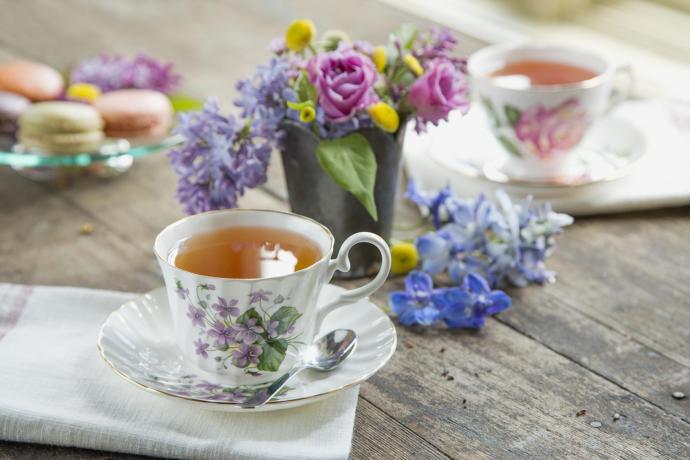
Herbal teas have been around for centuries. Yet, despite their name, "herbal tea" are not true teas at all. True teas, including green tea, black tea and oolong tea, are brewed from the leaves of the Camellia sinensis plant, with the basic difference being the amount of fermentation of the tea leaves before brewing. #herbal #tea
On the other hand, herbal teas are really infusions made from dried fruits, petals, flowers, seeds, spices or herbs. They come in a wide range of tastes and flavors, and make a tempting alternative to sugary beverages or water even if you are just drinking them for the flavor.
In addition to most of them being tasty, some herbal teas have health-promoting properties. In fact, herbal teas have been used as natural remedies for a variety of ailments- mostly in Eastern Medicine- for hundreds of years. Recently, modern science has begun to find evidence supporting some of the traditional uses of herbal teas, as well as some potential new ones.
These teas are generally categorized into seven groups: florals, fruity, citrusy, spicy, minty, camphorous, and herbaceous. And there isn't even agreement on the categories as there can be overlap between, say, fruity/citrusy, or champhorous/minty. The jury is out on the specific and as long as there are more two or more users/practitioners/herbal tea drinkers in the planet, their likely won't be a verdict. The best we can do is to understand the characteristics of each group. In Part 3, I will get into a little more detail of HOW they have these differences. For now, let's just go through the types, heat up some water , and pour a cup of your fave.
The lists given in each group are just a few popular examples of the group and are not meant to be totally inclusive. If you have questions about including any specific tea in your diet for medical reasons, I recommend that you consult a medical doctor before drinking them.
FLORALS

Florals include- obviously- the flowers and leaves of flowers including camomile, geranium, lavender, violets, clary sage, etc., the petals and rose hips from roses, and even dandelions. The common properties that the florals share include emotional benefits as well as benefits to the skin and hair.
FRUITY

Fruits include all the berries in the rose family- strawberries, raspberries, cranberries, etc. , fruits from the prunus/pome family- apple, plum, cherry, etc., and vine fruits such as grapes. The great thing about fruit teas is that they are not overly sweet yet still have all the benefits which can be found in the raw form of the fruit being infused. Getting a healthy dose of Vitamin C is a sure thing when drinking fruit-based tea.
CITRUSY

There are many impressive benefits for those who drink citrus tea. Since ancient times, it has been used to heal respiratory issues, such as coughs and sore throats, and was commonly brewed as a remedy for seasickness. The vitamin C can help stimulate the immune system of the body, aids in healing, and acts as an antioxidant. The stimulant nature of citrus tea and its essential oils can help to boost circulation. While most benefits are rather similar, there is a basic difference among the "warmth" nuances of each. Orange is considered a "warm" fruit, lime a "cool" fruit, with lemon in between the two. Grapefruit is considered "uplifting". That said, most blends with lemon or lemon balm are considered gently uplifting and are advertised as such. Orange goes well with black pepper- another "warm" biological- lime does not. Cool lime would be better paired with a cool mint. We'll learn more about "how" this comes about in the next Take, Part 3.
SPICY

Those spicy- and sometime woodsy flavors- of cinnamon, clove, nutmeg, ginseng, cardamon, turmeric, ginger and even black pepper can provide some powerful health benefits. All of the "spicies" help boost circulation, while cinnamon adds a kick to the immune system, nutmeg a detox boast, and cardamon and ginger both helping with digestion and stress. And that smell in your dentist's office is oil of clove, long known for its ability to kill toothaches, at least for a while. In a tea, they make a soothing combination of a pick-me-up and relaxing beverage at the same time. Go figure - - -
MINTY

Mint tea is a delightful and refreshing way to stay healthy and can help you boost your immune system, improve digestion and reduce aches and pains. Peppermint has long been used to treat irritable bowel syndrome and other digestive problems. Its fresh aroma and flavor makes it a tasty way to help your health: it's one of the most widely used "healthy teas" in the world. Mint tea is almost always mentha peperita . Its cousin- spearmint- is mentha spicata, just in case you actually have access to that information on the label. Peppermint is the "cooler" mint with spearmint being the "warmer" of the two. Rosemary- while botanically in the mint family- is one of those herbs that straddles a couple of groups- minty, champhorous, and herby.
It is know for its stomach soothing effect and ability to improve digestion. (Is it any wonder that restaurants have those little mints that they give you after a big meal?) . The mint- obviously- help keep your breath fresh. The menthol (more in this in Part 3) in mint is the active ingredient to soothe a sore throat, while relaxing the throat and chest muscles to help open up airways. Some studies have shown that mint has significant immune and antioxidant properties as well.
And, it's easy to grow mint, in fact, if it's not potted or at least well-contained in your garden, it can rapidly spread throughout! That hardiness is great, because it means you can even grow mint indoors, year round. Fresh peppermint leaves should be harvested in the morning when the leaves are still dewy for maximum health benefits. Hang the leaves until they dry completely and then store in an airtight jar until used for your tea.
CAMPHOROUS

Camphor is from the stemwood of the camphor laurel while rosemary contains up to 20% camphor. Also (arguably) in this group is tea tree with its well-regarded antiseptic properties. More typically sold as an oil, tea tree leaves for tea are available. These teas can produce that "icy-hot" sensation in the throat and nose and even those chest rubs that smell like turpentine, well, some of them actually DO have turpentine in them. Be careful with all camphorous botanicals- they are potent and an overdose can be potentially harmful. Eucalyptus is probably the most well-known of the camphorous herbs for teas and can help fight respiratory infections. It's also good for your pet koala (just kidding, but that's what they eat).
HERBACEOUS

Herbaceous- this is just a fancy way of saying that they smell like, well, plant-y herbs. Basil, oregano, thyme, bay, cumin, rosemary, thyme, sage, and many others- they are all herby, and most offer similar benefits of supporting the immune system and easing digestive problems.
Apologies to any of our friends out there with regard to separate minty, camphorous and herbaceous groupings. Yes, I know these categories are high combinable, interchangeable, confusing, misunderstood and overlapping. Just heat up some water and make a cup of your favorite tea while you wait for Part 3, coming soon.
 Holidays
Holidays  Girl's Behavior
Girl's Behavior  Guy's Behavior
Guy's Behavior  Flirting
Flirting  Dating
Dating  Relationships
Relationships  Fashion & Beauty
Fashion & Beauty  Health & Fitness
Health & Fitness  Marriage & Weddings
Marriage & Weddings  Shopping & Gifts
Shopping & Gifts  Technology & Internet
Technology & Internet  Break Up & Divorce
Break Up & Divorce  Education & Career
Education & Career  Entertainment & Arts
Entertainment & Arts  Family & Friends
Family & Friends  Food & Beverage
Food & Beverage  Hobbies & Leisure
Hobbies & Leisure  Other
Other  Religion & Spirituality
Religion & Spirituality  Society & Politics
Society & Politics  Sports
Sports  Travel
Travel  Trending & News
Trending & News
Most Helpful Opinions